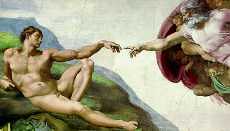



There's nothing wrong with seeing structure in nature. Believing that certain natural structures, particularly in us humans, are indicative of genetic superiority is a bit problematic.
You may think that eugenics has nothing in common with intelligent-design. After all, the eugenicists believe in evolution. Intelligent-designologists don't. But they both believe in humans as the pinnacle of creation, regardless of the mechanism of that creation. And they both place supreme importance on physical structure as a window into our natural superiority as humans.
But if instead of evolving through millions of years of natural selection and mutation, we were 'designed' by some etherial, omnipotent creator with an unfathomable 3D virtual reality simulator and then pieced together using a technology beyond our imagination, why do male mammals have nipples? And why did prehistoric whales have ankle bones?
Darwin believed that there are many complex interactions between species and their environment ( which includes other species ) that bring about the small subtle changes which over great spans of time amount to species' differentiation. Of course, he did put humans at the top of the evolutionary ladder. And the theory of eugenics is based on an interpretation of Darwin.
The intelligent-design folks pay some attention to Darwin when it comes to micro-evolution. But they refuse the idea that protozoa could have ever evolved into fish > into reptiles > into mammals > into us. On one level, intelligent-design may almost seem more egalitarian than Darwinism. Since species don't come from evolution, presumably they were all created in concert. All the symbioses in nature were concieved as a whole by the creator.
But I've heard I-D proponents use the 'Mount Rushmore' argument more than once; Compare the Grand Canyon to Mount Rushmore and you can easily see that one was designed and the other wasn't. Why they can't see the slow erosion of rocks by the wind as a form of design is beyond me.
I-D-ologists also tend to refer to Darwin's version of evolution as something that "couldn't have happened" --- past tense. In fact, any understanding of evloutionary theory accepts that evolution is ongoing, not something that occoured in the past and is now over with - like the Biblical Creation. I-D-ologists like to make a clear distinction between 'natural' processes and 'intelligent' ones. They see Darwinism as a 'naturalistic' theory, as if this is a bad thing. I suppose this is because of their faith in a Creator who is ABOVE nature. Any 'naturalistic' explanation of nature might insult the Creator.
The Eugenicists don't necessarily believe in a Creator, but they don't really believe in Nature (capital N) either. They see Humans (capital H) as nature's (small n) greatest creation but they're willing to accept Darwin. Of course, they don't rule out, nor does Darwin, that all of nature is the work of some divine power. Eugenics is not so much concerned with the history of evolution or creation, but with improving Man (capital M) into the future by weeding out nature's mistakes. Just where God fits into that equation is unclear.
The essential fact of all these theories is that they place us humans at the top of the mountain. Maybe we are at the top of the mountain. But so was Yertle the Turtle.
All this preoccupation with our physical evolution speaks to our need to define ourselves. The difficulty lies with our failure to reconcile our inability to understand the infinite complexity of nature, with our skill at recognizing & creating systems and patterns. We want to define the universe in terms we can, ourselves, comprehend and explain. We make a mistake, however, when we forget that we are not as smart as we think we are. Our logical assumptions about nature never tell the whole story.
Take Esperanto, the universal tongue. A well intentioned effort to unite the people of the world by creating a language not based on nations and geographical legacies, but on the idea of global community.
Presumably, if we all want the same thing - peace on Earth and goodwill... etc - Esperanto would catch on pretty quick. but it seems more likely that we will evolve into another species before Esperanto becomes even a second language for more than a few million people worldwide. I would venture to guess that there are more people in the U.S. speaking Klingon than Esperanto these days. This probably says more about American culure than it does about Esperanto... but the fact is that most attempts at imposing well thought out structures on God's most elegantly designed creatures end up being as effective as attempts to get drivers to all use their turn signals.
Life is messy. things may seem designed, but design is our invention, like Esperanto. English isn't becoming so widely spoken all over the world because it's well designed. English is one of the world's messiest languages. In spite of efforts to rein it in and make it behave, it keeps evolving, imperfect though it may be. English may not have been 'designed', but it is spoken (and mutated) by more people all the time.
I wish only that those who think that they can make the world better by imposing notions of structure - based not on science, but in ideology - would see how futile their efforts really are. the most powerful force in the universe is Entropy.
[back to top]
1 comment:
Dude,
I've been to the village of Herowana and tasted one of the beetles they call nanisani. Made my mouth numb for 8 hours. Just like a sitcom does for the brain.
Post a Comment